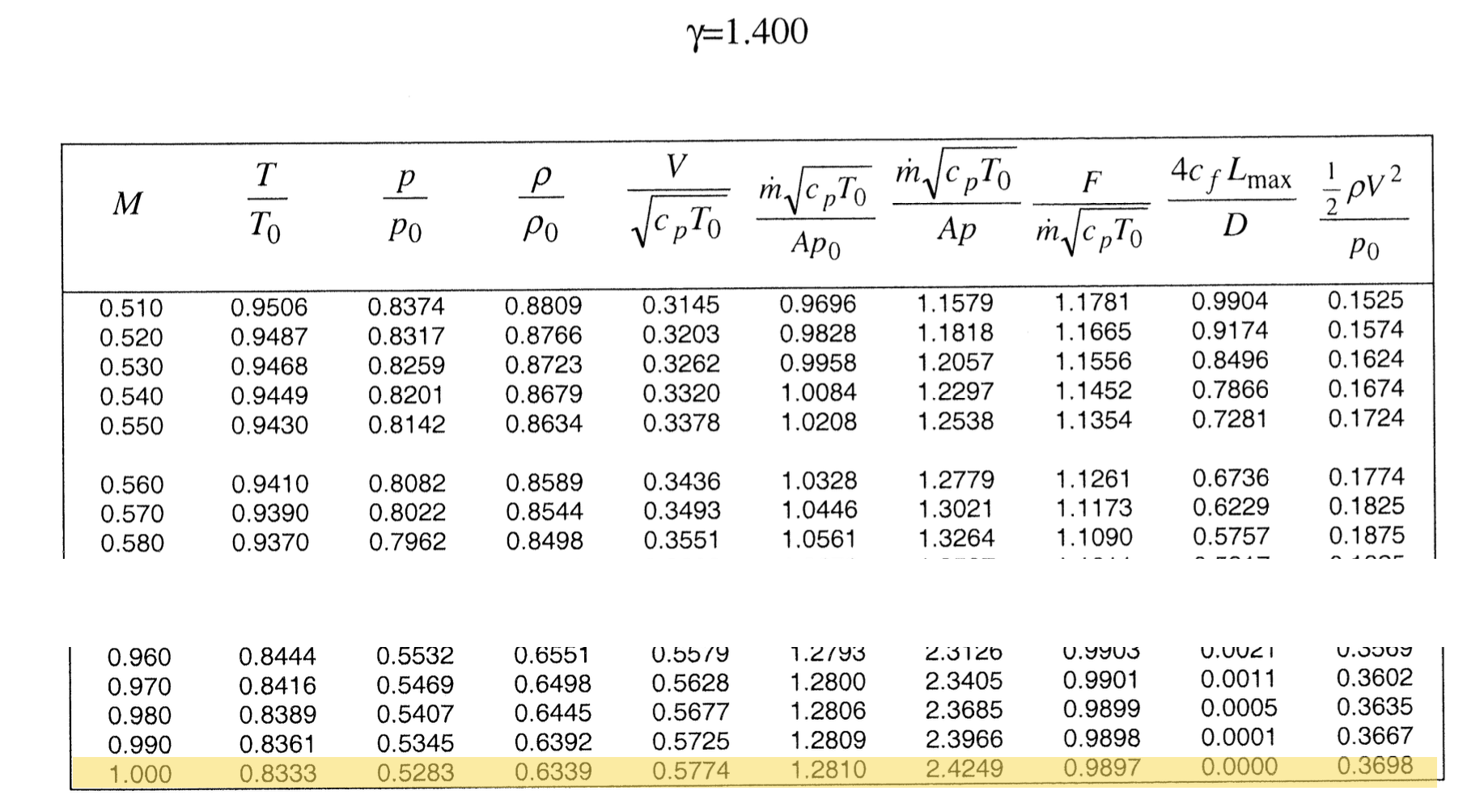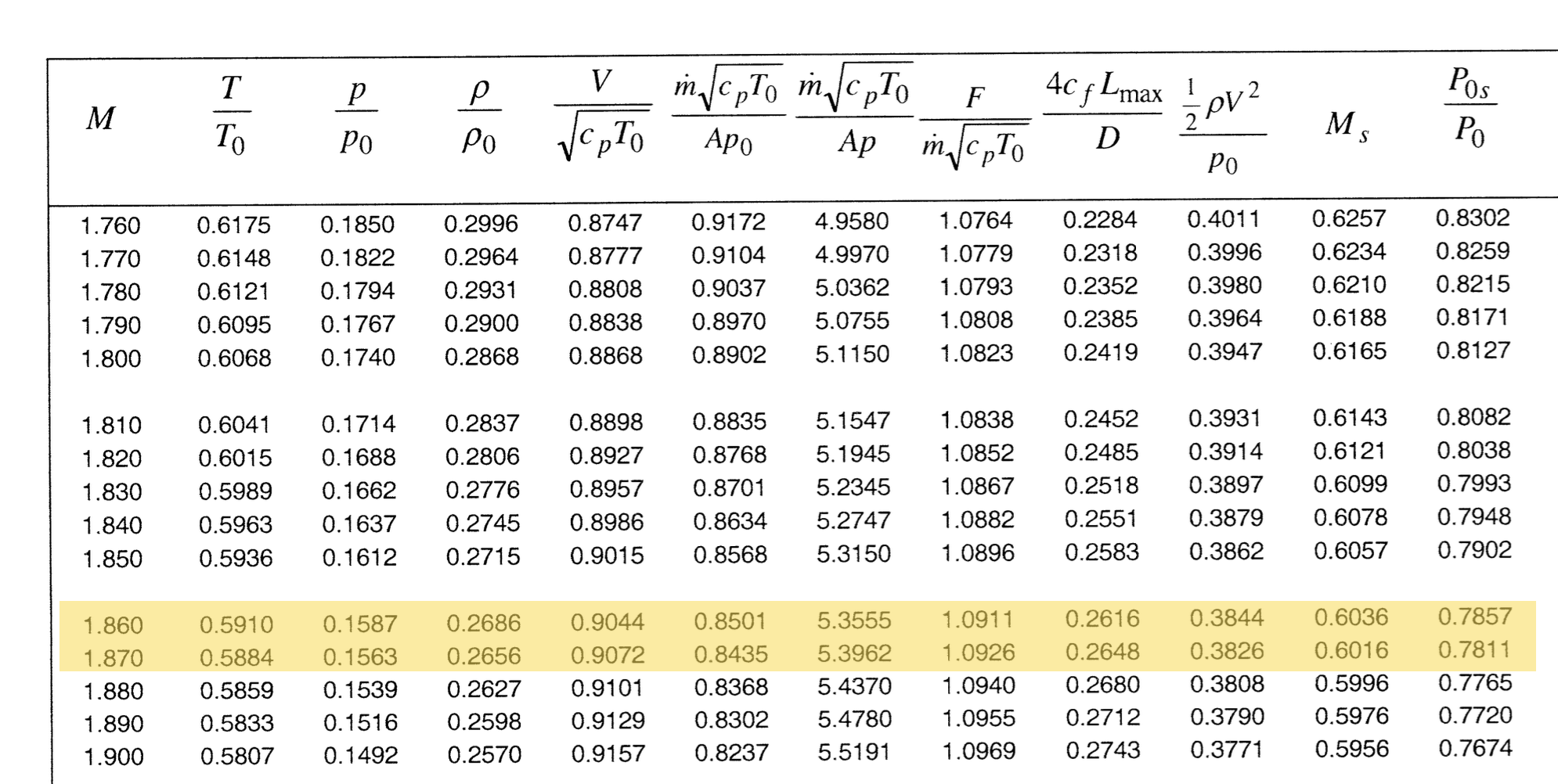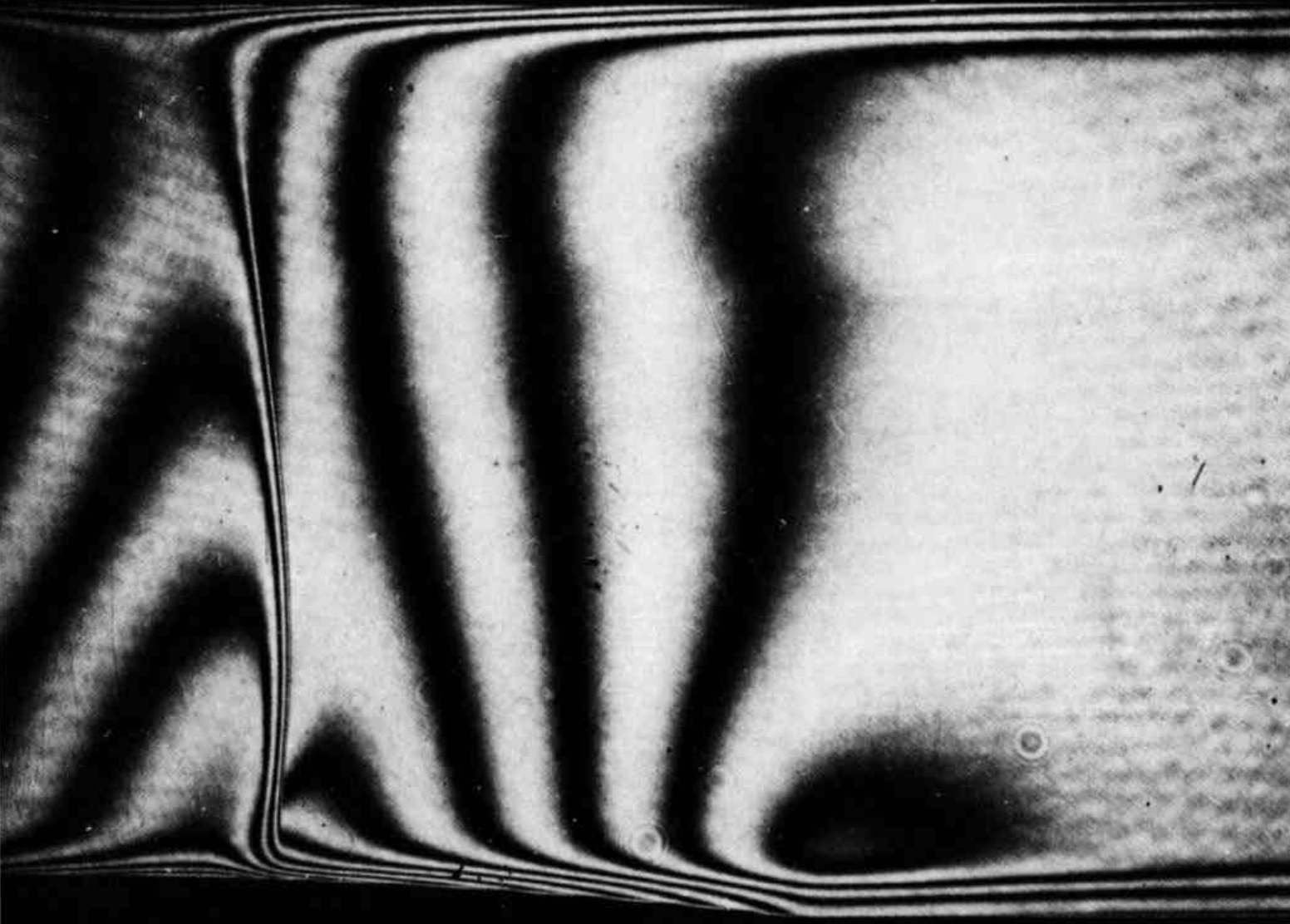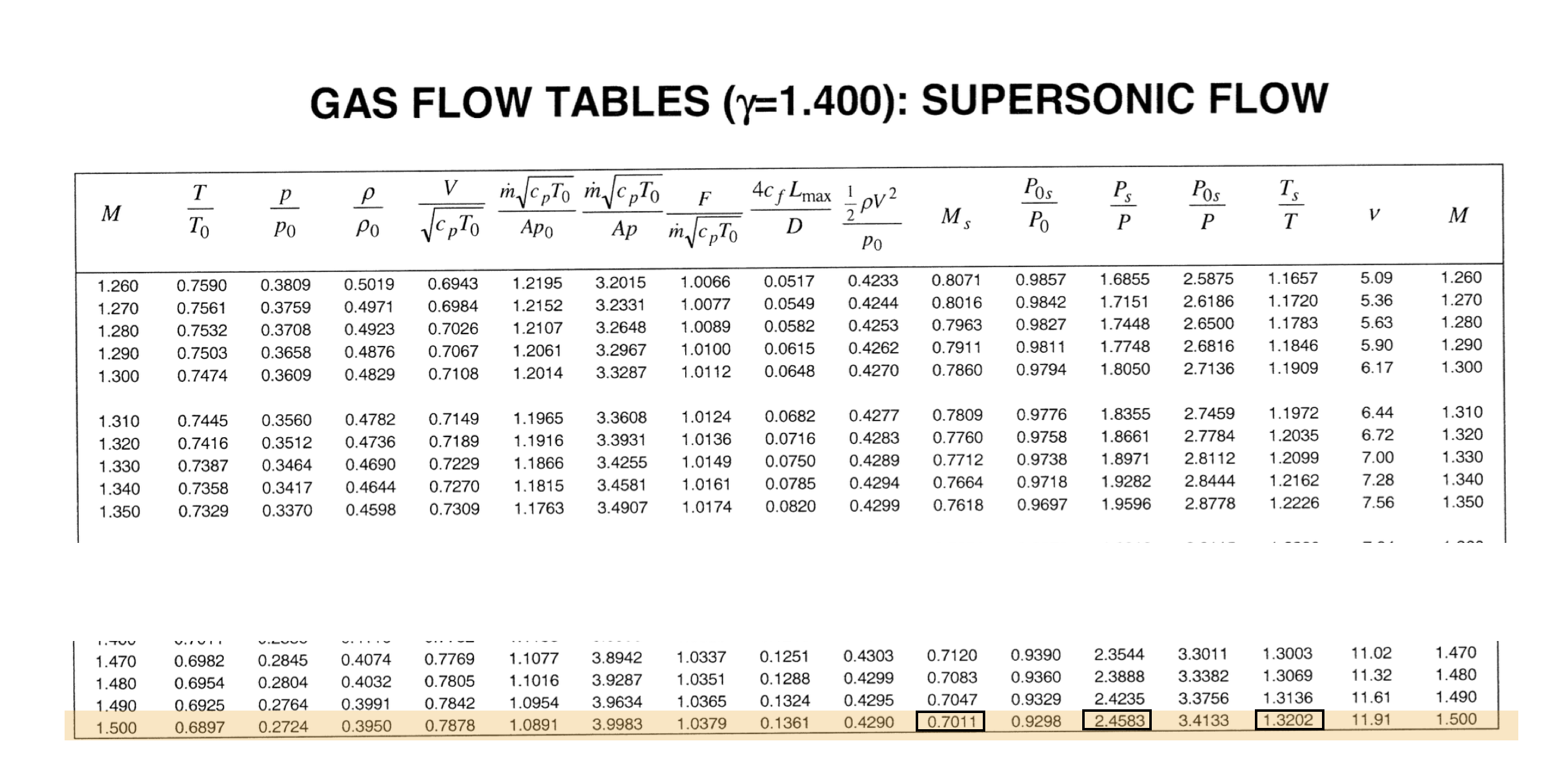Consider the converging diverging duct shown below. The ratio of the exit static pressure to the inlet stagnation pressure is \(0.7\). Assuming the throat is choked and that there is a shock in the diverging section, calculate
Solution
To begin, consider the last row of the subsonic tables. These are shown below.

Consider the column for the non-dimensional flow function
\[
\large
\require{color}
\frac{\dot{m} \sqrt{{\color[rgb]{0.986252,0.007236,0.027423}c}_{\color[rgb]{0.315209,0.728565,0.037706}p} {\color[rgb]{0.164799,0.878862,0.723179}T_0} }}{A {\color[rgb]{0.315209,0.728565,0.037706}p_0}}
\]
One can imagine that as the area changes within a duct, the Mach number will also change. However, assuming there is no shock, the stagnation pressure will stay the same; the stagnation temperature will also stay the same (even if there is a shock). So will the massflow rate (conservation) and \(\require{color}{\color[rgb]{0.986252,0.007236,0.027423}c}_{\color[rgb]{0.315209,0.728565,0.037706}p}\). Thus, this column is useful for understanding the relationship between the area and the Mach number. From the highlighted row in the table, we can write
\[
\large
\require{color}
\frac{\dot{m} \sqrt{{\color[rgb]{0.986252,0.007236,0.027423}c}_{\color[rgb]{0.315209,0.728565,0.037706}p} {\color[rgb]{0.164799,0.878862,0.723179}T_0} }}{A_{\star} {\color[rgb]{0.315209,0.728565,0.037706}p_0}} = 1.281
\]
where \(A_{\star}\) denotes the area where the flow chokes. Given that the area at the exit is twice of the area at the throat, and given the pressure ratio we have
\[
\large
\require{color}
\frac{\dot{m} \sqrt{{\color[rgb]{0.986252,0.007236,0.027423}c}_{\color[rgb]{0.315209,0.728565,0.037706}p} {\color[rgb]{0.164799,0.878862,0.723179}T_0} }}{A_{exit} {\color[rgb]{0.315209,0.728565,0.037706}p_{exit}}} = \frac{\dot{m} \sqrt{{\color[rgb]{0.986252,0.007236,0.027423}c}_{\color[rgb]{0.315209,0.728565,0.037706}p} {\color[rgb]{0.164799,0.878862,0.723179}T_0} }}{A_{\star} {\color[rgb]{0.315209,0.728565,0.037706}p_0}} \times \frac{{\color[rgb]{0.315209,0.728565,0.037706}p_0}}{{\color[rgb]{0.315209,0.728565,0.037706}p_{exit}}} \times \frac{A_{\star}}{A_{exit}}
\]
\[
\large
\require{color}
\Rightarrow \frac{\dot{m} \sqrt{{\color[rgb]{0.986252,0.007236,0.027423}c}_{\color[rgb]{0.315209,0.728565,0.037706}p} {\color[rgb]{0.164799,0.878862,0.723179}T_0} }}{A_{exit} {\color[rgb]{0.315209,0.728565,0.037706}p_{exit}}} = 1.281 \times \frac{1}{0.7} \times
\frac{1}{2} = 0.915
\]
where note that the denominator has \(\require{color}{\color[rgb]{0.315209,0.728565,0.037706}p_{exit}}\) which is a static pressure.

Using the tables again, we find that this value of \(0.915\) lies between \(0.8995\) and \(0.9227\), implying that the \(\require{color}{\color[rgb]{0.041732,0.352132,0.699576}M_{exit}}\) has values between \(\require{color}{\color[rgb]{0.041732,0.352132,0.699576}0.40}\) and \(\require{color}{\color[rgb]{0.041732,0.352132,0.699576}0.41}\). To work out exactly what this value is, we must interpolate; from the block of code below the corresponding exit Mach number is found to be \(\require{color}{\color[rgb]{0.041732,0.352132,0.699576}0.407}\).
Next, to work out the strength of the shock, i.e., its Mach number, we recognize that across the shock there will be a drop in the stagnation pressure. The stagnation pressure downstream of the shock will be the same stagnation pressure at the exit.
\[
\large
\require{color}
\frac{{\color[rgb]{0.315209,0.728565,0.037706}p_{0,exit} }}{{\color[rgb]{0.315209,0.728565,0.037706}p_{0} }} = \frac{\dot{m} \sqrt{{\color[rgb]{0.986252,0.007236,0.027423}c}_{\color[rgb]{0.315209,0.728565,0.037706}p} {\color[rgb]{0.164799,0.878862,0.723179}T_0} }}{A_{\star} {\color[rgb]{0.315209,0.728565,0.037706}p_{0}}} \times \frac{A_{\star}}{A_{exit}} \times \frac{A_{exit} {\color[rgb]{0.315209,0.728565,0.037706}p_{0,exit}}}{\dot{m} \sqrt{{\color[rgb]{0.986252,0.007236,0.027423}c}_{\color[rgb]{0.315209,0.728565,0.037706}p} {\color[rgb]{0.164799,0.878862,0.723179}T_0} }} = 1.281 \times \frac{1}{2} \times \frac{1}{0.817} = 0.784
\]
Note that the stagnation pressure at the throat is the same as the stagnation pressure at the inlet. The value of \(0.817\) arises by interpolating between the two highlighted flow capacities (stagnation pressure in the denominator).
Finally, we can use this value of the stagnation pressure ratio to work out the Mach number of the shock, using the table below.

Studying the last column, we note that the Mach number of the shock has to lie between \(\require{color}{\color[rgb]{0.041732,0.352132,0.699576}1.86}\) and \(\require{color}{\color[rgb]{0.041732,0.352132,0.699576}1.87}\). With a spot of interpolation the value calculated is \(\require{color}{\color[rgb]{0.041732,0.352132,0.699576}M_{shock}} = {\color[rgb]{0.041732,0.352132,0.699576}1.867}\).






